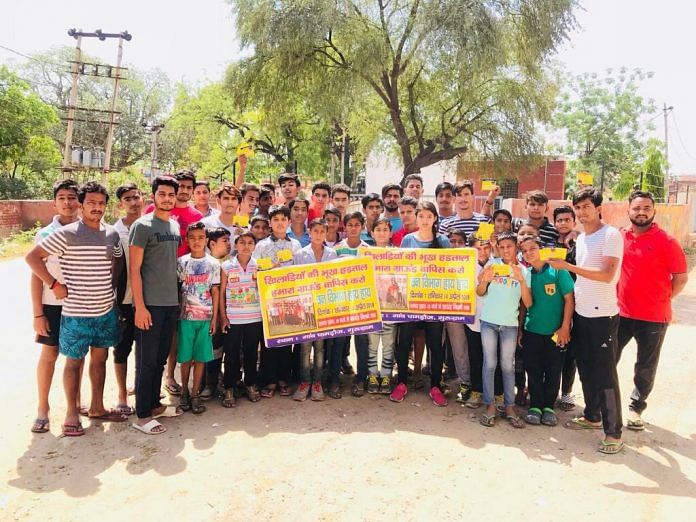Forest dept took over their ground, but the youth fought back through a hunger strike. The govt has promised them another piece of land, but it may take time.
Gurugram: Peaceful protests by children and young adults, a relentless hunger strike, and a small victory over the government – the little-known village of Ghamroj in the Gurugram district of Haryana witnessed all this last week.
And for what? For the love of the game of football.
The trouble began when the forest department took away the children’s football ground, saying it was part of Aravalli forest land.
Ghamroj, situated 20 km away from the posh colonies of Gurugram, is a Rajput-dominated village whose residents claim to be the descendents of Lord Ram. And the village is obsessed with football.
“For us, playing sport is as important as going to school,” said 20-year old Vivek Raghav, who has played football at the state level. “If they take away the ground on which we play and practice, we’re bound to protest.”
Vivek, along with over 50 other players in this nursery of football, sat on a hunger strike from 14 to 17 April.
Emotional and financial investment
The football ground is now unusable for practice – the forest department had removed the fences and goalposts put up on the field and planted trees there instead.
The piece of land lay unutilised until a couple of years ago, when players began to practice on the ground. Since then, the villagers have invested their emotions and their hard-earned money into it.
“It was such a huge piece of land and it wasn’t being used, so the children began to play there,” said Mukesh Raghav, who runs the football academy in the village. “Since then, we have invested our own money to constantly make the ground better for practice.”
The players agree. From levelling the land to growing grass on it, from putting up fences and goalposts to installing lights around the ground so one could practice even after dark, players say they and their families had financed everything themselves with no help from the government.
The public versus public servants
After the players’ protest, the government has relented and promised them another piece of land on which they can practice. However, this will only happen after four or five months.
“If the government does not want to help us, it’s fine. But it can’t ruin our efforts as well,” said Vivek. “On one hand, the PM talks about ‘Khelo India’, and on the other, the government does not let us play.”
He pulls out a copy of a letter to the Prime Minister written and signed by over 300 villagers.
Walls of the village bear slogans, graffiti and posters, all saying some variation of ‘van vibhaag haye haye” (shame on forest department). The villagers also documented every development related to their protest with videos, pictures and posts on a Facebook page titled ‘Mahesh Raghav Boka football’.
While players argue that the forest department’s fixation on the land stems from political reasons – they claim that forest minister Rao Narbir Singh didn’t want the land to be used by the villagers – they were not scared of taking on the government.
“Our parents stood behind us like a wall, and even protested along with us. The entire village came together,” said 17-year old Saurabh Raghav, who had to be hospitalised after two days of the hunger strike.
The players really weren’t alone. Ghoonghat-clad mothers, young girls and boys too sat on the hunger strike. “How could we cook or eat if our children were hungry?” said Anju Raghav, both of whose children – a son and a daughter – play football. Girls are equally passionate about sports in this village, she said — her daughter, 15-year old Khushi, too has played football at the state level.
“It is our children’s right to be able to play. Every time a player wins at a national level from Haryana, the government comes and appropriates them. Then why are they squashing our children’s efforts?” Anju asked.
Forest department stands its ground
While the villagers have been promised another ground by the government, the forest department remains steely in its resolve.
“We cannot base our decisions on the basis of what the villagers say,” said Naresh Kataria, a range officer. “The land is part of the forest land, and it cannot be taken away just like that.”
According to another government official, areas categorised as ‘gair mumkin pahar’ (uncultivable hill), ‘gair mumkin rada’ (foothills, pastures) and ‘banjar beed’ (cultivable grassy foothills) ought to be treated as part of the Aravalli hills, in addition to the reserved forests or places already classified as ‘forest’ in government records. This ground, the official said, falls under this protected area.
Opportunity lost
While the village panchayat and the forest department continue to be at loggerheads, players argue that they’ve just lost crucial time.
“We haven’t practised properly in months. Even if we get the ground that the government has promised us, we won’t be able to perform in state-level tournaments that start next month,” said Vivek.
“Even though the government gave in, it’s us players who have ultimately lost.”



